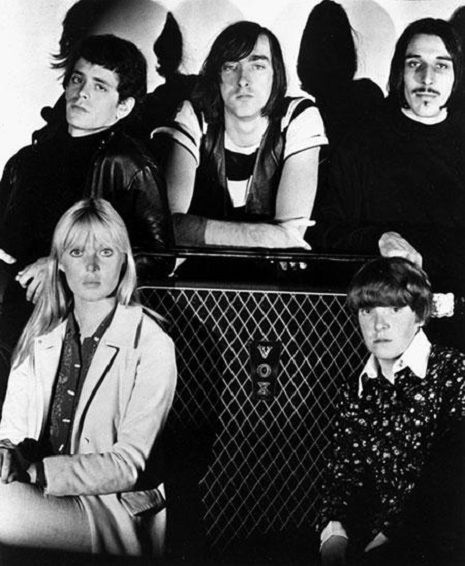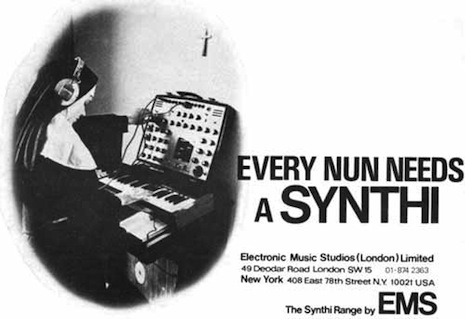
Marko, the Finnish Gerry Todd, takes you on a fascinating journey into the realm of magnetic tape and video machines.
This is a wonderful meditation video. Very relaxing.

Terrific entry in the BBC series The Seven Ages Of Rock.
The story of how artistic and conceptual expression permeated rock. From the pop-art multi-media experiments of Andy Warhol and the Velvet Underground to the sinister gentility of Peter Gabriel’s Genesis, White Light, White Heat Place traces how rock became a vehicle for artistic ideas and theatrical performance. We follow Pink Floyd from the fated art school genius of Syd Barrett through the global success of Dark Side of the Moon to the ultimate rock theatre show, The Wall. Along the way, the film explores the retro-futurism of Roxy Music and the protean world of David Bowie.

In the video below, an Indian sadhu accuses Monsanto chemicals of polluting India, resulting in the growth of large vegetables with no “power” (nutrition).
Illegal genetic modification experiments have been going on across India with the complicity of the Indian Government. Over an estimated 125,000 farmers have committed suicide as a result of the ruthless drive to use India as a testing ground for genetically modified crops. But, India’s farmers are fighting back:
“We send today, a very clear message to all those who have invested in Monsanto in India and abroad; take your money out now, before we reduce it to ashes”.
Karnataka State Farmers Association, India
Read about the farmers struggle here.
Read about Monsanto’s mission to create and own the planet’s food here.
In his new book, The World in 2050: Four Forces Shaping Civilization’s Northern Future, UCLA geologist Dr. Laurence C. Smith, a rising star in geoscience, distills cutting edge scientific research into four global forces (demographic trends, natural resource demand, climate change, and globalization) to offer a vivid prediction of what the world we leave to our children and grandchildren will be like.

Dangerous Minds pal, Michael Backes (who named the above strain) writes:
“Most books about marijuana are hampered by shoddy research and threadbare science. As cannabis legalization and decriminalization approaches its tipping point in the US, it’s refreshing that Dr. Julie Holland has published, The Pot Book, the most comprehensive overview available of cannabis, its medical uses and societal ramifications. What makes “The Pot Book” truly significant is the depth of its coverage and the breadth of its fifty contributors.
Dr. Holland, who spent a decade as an ER psychiatrist at Bellevue Hospital in New York City, is also the author of The Ecstasy Book, the standard work on MDMA and its medicinal applications. For The Pot Book, Holland has convened a who’s who of esteemed contributors, ranging from Dr. Raphael Mechoulam, the discoverer of THC, to contemporary social critic, Douglas Rushkoff. The book covers everything from the latest on cannabis botany from Dr. Lyle Craker, the UMass professor that is attempting to break the US government’s monopoly on research-grade cannabis to Dr. Marsha Rosenbaum’s essay on how to speak to kids about marijuana. The book is supplemented by a website with additional articles and interviews that didn’t make the cut for the book, plus a collection of excellent links to cannabis science and sociology. All proceeds from sales of the book go to support research into cannabinoid medicines.”
Dr. Julie Holland writing on The Pot Book website:
After three years of putting this book together, I’m convinced that cannabis can be re-introduced to physicians and patients as the multifaceted medicine it once was. I think what we will see in the next decade or so is an explosion of research into the therapeutic use of cannabinoids as medications. If you’d like to donate to the Holland Fund for Therapeutic Cannabinoid Research, please click here.
Before pot was illegal, it was a medicine used for thousands of years to treat everything from muscle spasms to insomnia. Cannabis has powerful anti-inflammatory activity, it can act as a free-radical scavenger, and most importantly, cannabis has anti-cancer activity. Cannabinoids can kill cancer cells by apopotosis (triggering programmed cell death) while sparing healthy cells, and can also prevent tumor blood supplies from forming, which is called angiogenesis.
Cannabinoids also have a pro-metabolic effect, meaning they may be helpful in stopping the progression of diabetes (partially through its anti-inflammatory action on the cells of the pancreas), as well as helping to normalize blood sugar and cholesterol levels.
Cannabis is a medicine that can slow the prevention of atherosclerosis (hardening of the arteries, the cause of many heart attacks and strokes) and can modify autoimmune diseases including arthritis, Chron’s disease, and Multiple Sclerosis. (Cannabis doesn’t just relax the spasming muscles and bladders of MS patients; it actually seems to modify the course of illness and may slow neurodegeneration through its neuroprotective effect. The United States has taken out a patent on the use of cannabis as a neuro-protectant, though they continue to keep the plant in Schedule I, reserved for drugs with the highest potential for abuse and no medicinal use. Groups of physicians and nurses including the American Medical Association have requested a review of this scheduling.
But there are other important uses of this plant. Cannabis seeds are a complete vegetarian protein and can be used as food for people, livestock, and birds. Hempseed oil not only provides the exact ratio of essential fatty acids our bodies need, but it can also be used as a fuel. Hempseed oil is a renewable fuel source, which could decrease our reliance on foreign oil. Hemp (the non-psychoactive stalk of the cannabis plant) can make many consumer goods including paper (decreasing deforestation that complicates our climate maintenance) rope, canvas, and clothing more absorbent than cotton. Importantly, with compostable cellulose, hemp can replace our current plastic bag and Styrofoam “plastic vortex”/landfill crisis.
Cannabis is an ancient medicinal plant used for thousands of years until it was made illegal in 1937, soon after alcohol prohibition was repealed. We are currently imprisoning more people than any other country on the planet, with nearly half of our prisoners serving time for drug offenses. New York City, where I practice medicine, arrests more people for marijuana offenses than any other city in the US. Although Caucasians constitute the majority of pot smokers, African-Americans and Latinos experience a disproportionate number of marijuana-related arrests.
Renewable bio-fuel, food, rope, canvas, clothing, paper, medicine, and relaxant, and America can’t have any of it.
Because it make them laugh. As a psychiatrist, I have to tell you: This is insanity.

If it’s not the Large Hadron Collider causing a black hole to form, sucking up our universe into dark matter, then it’s something else. Sometimes the supposed “elegance” of modern physics just crawls up its own ass, don’t you think? The end of time is a bloody long ways off, in any case. Sez me.
Look out into space and the signs are plain to see. The universe began in a Big Bang event some 13 billion years ago and has been expanding ever since. And the best evidence from the distance reaches of the cosmos is that this expansion is accelerating.
That has an important but unavoidable consequence: it means the universe will expand forever. And a universe that expands forever is infinite and eternal.
Today, a group of physicists rebel against this idea. They say an infinitely expanding universe cannot be so because the laws of physics do not work in an infinite cosmos. For these laws to make any sense, the universe must end, say Raphael Bousso at the University of California, Berkeley and few pals. And they have calculated when that is most likely to happen.
Their argument is deceptively simple and surprisingly powerful. Here’s how it goes. If the universe lasts forever, then any event that can happen, will happen, no matter how unlikely. In fact, this event will happen an infinite number of times.
This leads to a problem. When there are an infinite number of instances of every possible observation, it becomes impossible to determine the probabilities of any of these events occurring. And when that happens, the laws of physics simply don’t apply. They just break down. “This is known as the “measure problem” of eternal inflation,” say Bousso and buddies.
In effect, these guys are saying that the laws of physics abhor an eternal universe.
The only way out of this conundrum is to hypothesise some kind of catastrophe that brings an end to the universe. Then all the probabilities make sense again and the laws of physics regain their power.
Read more of Time Likely To End Within Earth’s Lifespan, Say Physicists (MIT Technology Revew)

Toyota Proto, 1957

Nissan Prince Sprint 1900 Prototype, 1963

Toyota EX-II, 1969

Mazda RX-500, 1970
Pink Tentacle currenlty has a great post on Japanese concept cars from 1957-2009. I’m not so sure about the Toyota EX-II from 1969, tho… Yikes!
See a few more concept cars after the jump…

Dangerous Minds pal Brian Tibbetts, a sound designer at Lucas Arts, sent this unusual item my way this morning regarding a literally microscopic instrument called the Micronium, developed by students at the University of Twente in the Netherlands. The instrument is about 1/10 of the thickness of a human hair and from what I can gather, is a bit like playing a microscopic comb with tiny, tiny weights.
On Sunday there was a recital for the composition, “Impromptu No. 1 for Micronium” in Enschede, Holland. The music starts at about 6 minutes in and goes from random Fantastic Planet type tone generation to a perfect micro-rendition of Hot Butter’s one-hit Moog wonder “Popcorn,” which I thought was a pretty rad choice to demo this sucker:
Via PopSci.com

“Think of a sound—now make it.”
Here is a very cool doc by Ian Collie about London’s Electronic Music Studios, the pioneering synthesizer company formed in 1969 that created such items as the voltage controlled synth (VCS3) and the Synthi A.
These and other machines changed the way we listened to music forever. They were used by some of the first pop artists to experiment with electronic music, including Pink Floyd, The Who, Eno & Roxy Music, Tangerine Dream, Kraftwerk and Hawkwind.
Collie puts together a very human and warm exploration of what sound synthesis meant to the lives of EMS principals Peter Zinovieff, Tristram Cary and David Cockerell. And in a segment that involves Hawkwind’s David Brock, he also takes on how well sound synthesis meshed with the psychedelic age.
After the jump, catch parts 2 & 3…